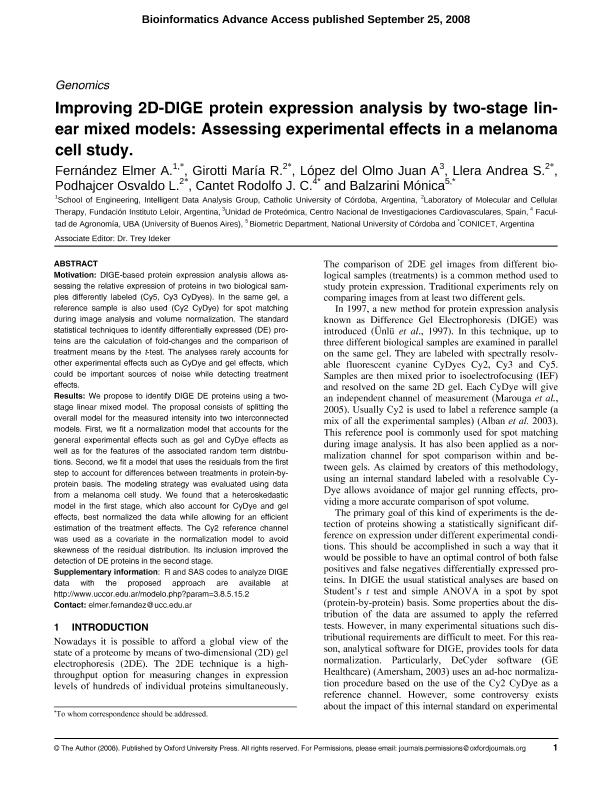Artículo
Improving 2D-DIGE protein expression analysis by two-stage linear mixed models: Assessing experimental effects in a melanoma cell study
Fernandez, Elmer Andres ; Girotti, Maria Romina
; Girotti, Maria Romina ; López del Olmo, Juan A.; Llera, Andrea Sabina
; López del Olmo, Juan A.; Llera, Andrea Sabina ; Podhajcer, Osvaldo Luis
; Podhajcer, Osvaldo Luis ; Cantet, Rodolfo Juan Carlos
; Cantet, Rodolfo Juan Carlos ; Balzarini, Monica Graciela
; Balzarini, Monica Graciela
 ; Girotti, Maria Romina
; Girotti, Maria Romina ; López del Olmo, Juan A.; Llera, Andrea Sabina
; López del Olmo, Juan A.; Llera, Andrea Sabina ; Podhajcer, Osvaldo Luis
; Podhajcer, Osvaldo Luis ; Cantet, Rodolfo Juan Carlos
; Cantet, Rodolfo Juan Carlos ; Balzarini, Monica Graciela
; Balzarini, Monica Graciela
Fecha de publicación:
12/2008
Editorial:
Oxford University Press
Revista:
Bioinformatics (Oxford, England)
ISSN:
1367-4803
Idioma:
Inglés
Tipo de recurso:
Artículo publicado
Clasificación temática:
Resumen
Motivation: Difference in-gel electrophoresis (DIGE)-based protein expression analysis allows assessing the relative expression of proteins in two biological samples differently labeled (Cy5, Cy3 CyDyes). In the same gel, a reference sample is also used (Cy2 CyDye) for spot matching during image analysis and volume normalization. The standard statistical techniques to identify differentially expressed (DE) proteins are the calculation of fold-changes and the comparison of treatment means by the t-test. The analyses rarely accounts for other experimental effects, such as CyDye and gel effects, which could be important sources of noise while detecting treatment effects. Results: We propose to identify DIGEDE proteins using a two-stage linear mixed model. The proposal consists of splitting the overall model for the measured intensity into two interconnected models. First, we fit a normalization model that accounts for the general experimental effects, such as gel and CyDye effects as well as for the features of the associated random term distributions. Second, we fit a model that uses the residuals from the first step to account for differences between treatments in protein-by-protein basis. The modeling strategy was evaluated using data from a melanoma cell study. We found that a heteroskedastic model in the first stage, which also account for CyDye and gel effects, best normalized the data, while allowing for an efficient estimation of the treatment effects. The Cy2 reference channel was used as a covariate in the normalization model to avoid skewness of the residual distribution. Its inclusion improved the detection of DE proteins in the second stage.
Palabras clave:
Melanoma
,
2d Dige
,
Bioinformatics
,
Protein Expression
Archivos asociados
Licencia
Identificadores
Colecciones
Articulos(CCT - CORDOBA)
Articulos de CTRO.CIENTIFICO TECNOL.CONICET - CORDOBA
Articulos de CTRO.CIENTIFICO TECNOL.CONICET - CORDOBA
Articulos(IIBBA)
Articulos de INST.DE INVEST.BIOQUIMICAS DE BS.AS(I)
Articulos de INST.DE INVEST.BIOQUIMICAS DE BS.AS(I)
Articulos(OCA PQUE. CENTENARIO)
Articulos de OFICINA DE COORDINACION ADMINISTRATIVA PQUE. CENTENARIO
Articulos de OFICINA DE COORDINACION ADMINISTRATIVA PQUE. CENTENARIO
Citación
Fernandez, Elmer Andres; Girotti, Maria Romina; López del Olmo, Juan A. ; Llera, Andrea Sabina; Podhajcer, Osvaldo Luis; et al.; Improving 2D-DIGE protein expression analysis by two-stage linear mixed models: Assessing experimental effects in a melanoma cell study; Oxford University Press; Bioinformatics (Oxford, England); 24; 23; 12-2008; 2706-2712
Compartir
Altmétricas



